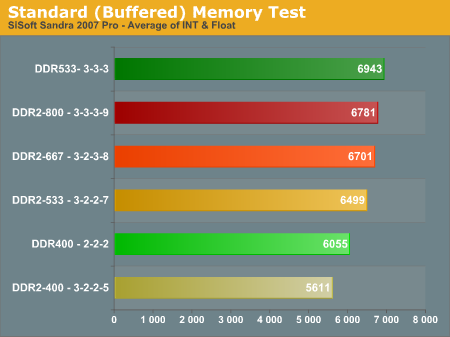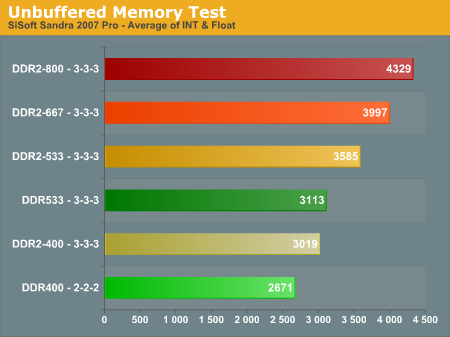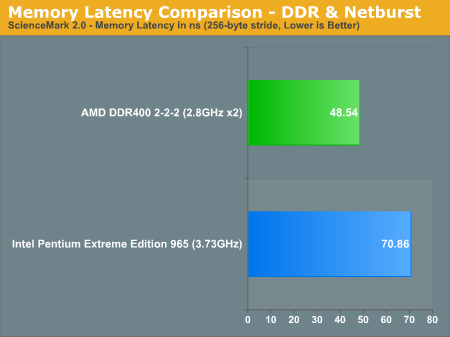DDR/NetBurst Memory Bandwidth and Latency
One of the most talked-about AMD advantages of the last couple of years has been their on-processor memory controller. This has allowed, according to popular theories, the Athlon64 to significantly outperform Intel NetBurst processors. The fact is NetBurst DDR2 bandwidth has recently been similar or wider in bandwidth than Athlon64 - even when the DDR is overclocked. You can see this clearly when we compare Buffered and Unbuffered Bandwidth of a NetBurst 3.46EE to an AMD 4800+ x2(2.4GHz, 2x1MB Cache) running DDR400 2-2-2 and running overclocked memory at DDR533 3-3-3.
The green bars represent DDR memory performance, while the beige to red are increasing DDR2 speed on NetBurst. Light green represents DDR400 2-2-2 while Dark Green is overclocked memory at the same CPU speed, DDR533 at 3-3-3.

In buffered performance, Fast DDR400 is only faster than DDR2-400 and slower than DDR2-533, 667 and 800. Overclocked memory at DDR533 3-3-3 is faster than any of the DDR2 bandwidths on NetBurst.
The Sandra Unbuffered Memory Test, which turns off features that tend to artificially boost performance, is generally a better measure of how memory will behave comparatively in gaming. The same green for DDR applies here.

Without Buffering, DDR400 has the smallest bandwidth of tested memory speeds and timings. Even overclocking to DDR533 allows the DDR to barely beat DDR2-400. DDR2-533, 667, and 800 all have greater Unbuffered bandwidth than the DDR overclocked to 533. NetBurst DDR2 memory bandwidth is generally wider than the bandwidth supplied by DDR memory on Athlon64. Despite the wider bandwidth, the deep pipelines and other inefficiencies in the NetBurst design did not allow the NetBurst processors to outperform Athlon64. Keep this in mind later, when we look at AM2 and Core 2 Duo Memory Bandwidth.
Latency
The other area where AMD has had an advantage over NetBurst DDR2 performance is memory latency, the result of the on-processor memory controller. Comparison of the AMD DDR Memory controller and the Intel DDR2 Memory controller in the Intel chipset shows AMD DDR with latency about 35% lower than Intel NetBurst in Science Mark 2.0.

While memory bandwidth was very similar between AMD and NetBurst, the deep pipes of the NetBurst design still behaved as if they were bandwidth starved. On the other hand the AMD architecture made use of the bandwidth available and the much lower latency to outperform NetBurst across the board.
One of the most talked-about AMD advantages of the last couple of years has been their on-processor memory controller. This has allowed, according to popular theories, the Athlon64 to significantly outperform Intel NetBurst processors. The fact is NetBurst DDR2 bandwidth has recently been similar or wider in bandwidth than Athlon64 - even when the DDR is overclocked. You can see this clearly when we compare Buffered and Unbuffered Bandwidth of a NetBurst 3.46EE to an AMD 4800+ x2(2.4GHz, 2x1MB Cache) running DDR400 2-2-2 and running overclocked memory at DDR533 3-3-3.
The green bars represent DDR memory performance, while the beige to red are increasing DDR2 speed on NetBurst. Light green represents DDR400 2-2-2 while Dark Green is overclocked memory at the same CPU speed, DDR533 at 3-3-3.

In buffered performance, Fast DDR400 is only faster than DDR2-400 and slower than DDR2-533, 667 and 800. Overclocked memory at DDR533 3-3-3 is faster than any of the DDR2 bandwidths on NetBurst.
The Sandra Unbuffered Memory Test, which turns off features that tend to artificially boost performance, is generally a better measure of how memory will behave comparatively in gaming. The same green for DDR applies here.

Without Buffering, DDR400 has the smallest bandwidth of tested memory speeds and timings. Even overclocking to DDR533 allows the DDR to barely beat DDR2-400. DDR2-533, 667, and 800 all have greater Unbuffered bandwidth than the DDR overclocked to 533. NetBurst DDR2 memory bandwidth is generally wider than the bandwidth supplied by DDR memory on Athlon64. Despite the wider bandwidth, the deep pipelines and other inefficiencies in the NetBurst design did not allow the NetBurst processors to outperform Athlon64. Keep this in mind later, when we look at AM2 and Core 2 Duo Memory Bandwidth.
Latency
The other area where AMD has had an advantage over NetBurst DDR2 performance is memory latency, the result of the on-processor memory controller. Comparison of the AMD DDR Memory controller and the Intel DDR2 Memory controller in the Intel chipset shows AMD DDR with latency about 35% lower than Intel NetBurst in Science Mark 2.0.

While memory bandwidth was very similar between AMD and NetBurst, the deep pipes of the NetBurst design still behaved as if they were bandwidth starved. On the other hand the AMD architecture made use of the bandwidth available and the much lower latency to outperform NetBurst across the board.










118 Comments
View All Comments
Zebo - Tuesday, July 25, 2006 - link
Nice one Wes and it makes sense no matter what to have memory testing done on the top dog platform, Conroe.Mclendo06 - Tuesday, July 25, 2006 - link
Is there any reason that either company, Intel or AMD, couldn't design a future processor both with an intelligent pre-fetching algorithm such as is seen in the Core 2 Duo and an on-die memory controller like on the AM2 processors? Seems like the apparent memory latencies could be dropped very significantly by combining these features.Calin - Tuesday, July 25, 2006 - link
We are hoping in the next big update to AMD processor (the K8L) to have some kind of intelligent prefetching (it is entirely possible, but it costs a number of transistors). Possibly that "intelligent prefetching" means reordering loads from memory, and this happens before the memory controllerIngas - Tuesday, July 25, 2006 - link
How can Core 2 Duo do prefetch before memory controller?
I miss some point, do I?
Calin - Wednesday, July 26, 2006 - link
I wasn't clear enough. The memory controller gets requests for memory, and returns that memory. Nothing more, nothing less.All the logic for preordering is housed in the proper microprocessor, and not in the memory controller - as such, it has no relation with the integrated/discrete implementation of the memory controller.
vailr - Tuesday, July 25, 2006 - link
Has anyone run: a Core2 Duo CPU comparison of DDR vs. DDR2, running on the ASrock 775Dual-VSTA? To determine how much slowdown would occur, by using the older DDR memory?Ingas - Tuesday, July 25, 2006 - link
Interesting point!Maybe Core intelligent look-ahead so intelligent, that it even performs equaly on DDR!
Hm.
Very interesting!
Gary Key - Tuesday, July 25, 2006 - link
We will show this in our review. ASRock just released bios 1.4 that addressed a few issues we noticed in our preview of the board.photoguy99 - Tuesday, July 25, 2006 - link
...that AMD is thoroughly owned.It's amazing the arguments have still persisted up until now about excuses for Core2 doing so well.
It was mentioned that AMD survived before at the lower end of the market - but remember how much trouble they had? There were losing money all the time back then. Now they have taken *all* of their 2.5B cash reserve and spent it on ATI. Nice.
It hurt AMD's credibility even more when Dirk Diggler recently said 4x4 was going to be an answer to Core2. Right. After 30 years of dual socket systems being a niche they are finally going to take off and save you - good luck with that.
duploxxx - Tuesday, July 25, 2006 - link
because you have no idea what is going behind the scene and only looking at performance of a desktop cpu and think this is the real world.almost no review site is proud enough to get up against the hyping marketing machine from intel. well then believe the marketing hype and own a cpu that has a crapy design when it comes to real multithread and 64bit. way to go to the future knowing vista is comming your way.
multicore/multisocket is the future, even intel knows it.
amd is in a much stronger position know and by the end of this year the make procs with a price tag 50% lower than intel intel can only counter this by going to 45nm end of 2007. knowing the cost of all the intel crew, fabs and size of the processors.